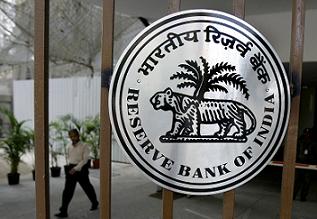RBI on Tuesday injected Rs 32,000
crore into the system by lowering the Cash Reserve Ratio (CRR) by
half-a-percentage point but kept the short-term lending rate unchanged
in view of persisting inflationary concerns.
 The followings are the highlights of the third-quarter review of the Monetary Policy announced by Reserve Bank of India Governor D Subbarao:
The followings are the highlights of the third-quarter review of the Monetary Policy announced by Reserve Bank of India Governor D Subbarao:
* Cash reserve ratio lowered by 0.50 pc to 5.5 pc
* Short term lending rate (repo) retained at 8.5 pc
* Short-term borrowing rate unchanged at 7.5 pc
* CRR cut to infuse additional Rs 32,000 crore liquidity
* GDP growth estimate for 2011-12 cut to 7 pc from 7.6 pc
* Downside risks to growth have increased
* March-end inflation projection at 7 pc
* Upside risks to inflation remains
* Bank rate retained at 6 per cent
* Fiscal slippages threat to economic stability
* Investment, capital inflows have slowed down
* Fiscal deficit to overshoot Budget estimate
* Injected Rs 70,000 cr in November-January through OMOs
* Next review of monetary policy on 15th March.
"Based on the current
inflation trajectory, including consideration of suppressed inflation,
it is premature to begin reducing the policy rate," RBI Governor D
Subbarao said while unveiling the third quarterly monetary policy
review.
With additional liquidity by CRR cut, there is a possibility that banks may reduce the interest rate to attract borrowers.
Projecting
a lower growth of 7 per cent for 2011-12, the Reserve Bank said the
policy actions are meant to "mitigate downside risks to growth" and
anchor inflationary expectations.
The
CRR, the amount of deposits the banks are required to keep with RBI in
cash, has been reduced to 5.5 per cent from 6 per cent with effect from
28th January, releasing Rs 32,000 crore in the system to ease the liquidity problems.
The short-term lending rate (repo) has been kept unchanged at 8.5 per cent.
The
policy said through the multiplier effect, additional credit to the
tune of Rs 1.6 lakh crore would be generated in the system over a period
of time.
The stock market reacted positively to the policy announcement and the banking stocks, in particular, shot up.
The
RBI retained the repo or the short-term lending rate at 8.5 per cent
while making it clear that any cut in it will only happen after
moderation in inflation.
Subbarao said,
"Even as inflation remains elevated, despite moderation, downside risks
to growth have increased. The growth-inflation balance of the monetary
policy stance has now shifted to growth".
He further said
slippage on fiscal deficit, crude prices and rupee depreciation are key
challenges for inflation, which after remaining near double digit for
almost two-years, came down to 7.5 per cent in December 2011.
The central bank
expects the headline inflation to moderate to 7 per cent by March, but
there are concern over the persistently high prices of non-food
manufacturing items.
The Chairman of
Prime Minister's Economic Advisory Panel, C Rangarajan, said RBI has
taken a "wise decision" and it would lead to softening of interest rate.
"The improvement in
liquidity condition will automatically have effect on interest rate.
Improvement in liquidity condition will lead to softening of interest
rate," he said.
On CRR cut, RBI said,
"Persistence of tight liquidity conditions could disrupt credit flow and
further exacerbate growth risks...CRR is the most effective instrument
for permanent liquidity injections..."
It indicated that future rate actions can see more lowering on the front.
Apart from easing
liquidity pressures, the RBI said the policy actions are aimed at
mitigating downside risks to growth and anchoring medium term inflation
expectations.
Liquidity deficit has
been consistently above the RBI's comfort level for the past three
months, with banks' borrowing from the overnight borrowing going up to
Rs 1.20 lakh crore this month.
The Reserve Bank has
been using its "first instrument of choice", the open market operations
(OMO) to tide over the liquidity concerns, and has bought back Rs 70,000
crore worth of government securities from the market in the recent
past.
Subbarao, however, said
that growth will be faster next fiscal than the current one and the
Reserve Bank will come out with a formal projection in its annual
monetary policy statement on 17th April.
A shift to growth marks a significant change in the thinking process at Mint Road
as it had been working with a single point agenda of managing inflation
for 18 months till the December mid-quarter review, when it hinted at
taking a dovish stance.
The inflation-directed rate tightening saw 13 hikes and an effective increase of 3.75 per cent in the lending rate.
Reacting to the
policy, Oriental Bank of Commerce Executive Director S C Sinha said, "It
is a welcome step. It will inject much needed liquidity in the system".
The RBI policy action
definitely lead to reduction of interest rates. Softening of rates will
take place in coming days, he said.
RBI said the fiscal
deficit will "substantially" overshoot the budgeted level of 4.6 per
cent and will be "constrained" to not lower rates if the fiscal
consolidation process is not carried out in earnest.
"The anticipated
fiscal slippage, which is caused largely by high levels of consumption
spending by the government, poses a significant threat to both inflation
management and more broadly, to macroeconomic stability, it said.
It said the Union Budget for 2012-13 must address these concerns in a "credible' and "sustainable" manner.
As an immediate
measure, the RBI has suggested de-controlling of diesel prices along
with keeping a tab on food subsidy, which will take care of both
aggregate demand and trade deficit.

No comments:
Post a Comment